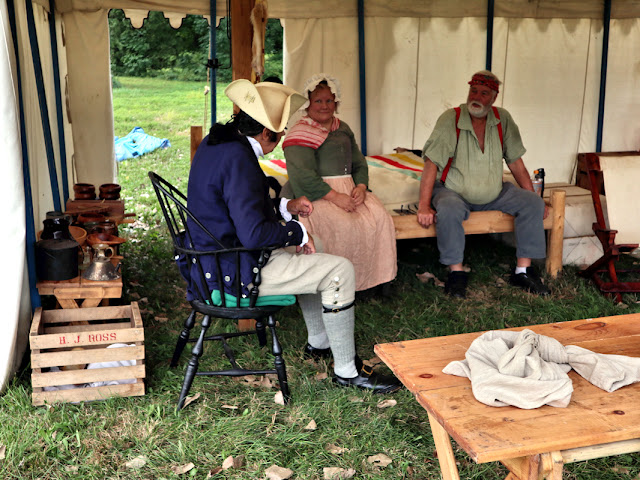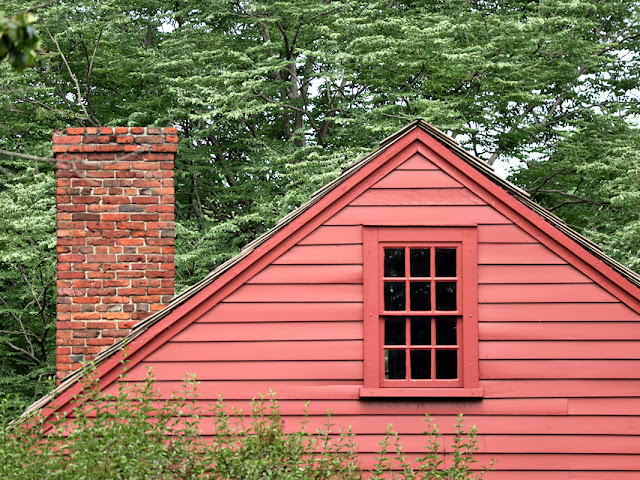I have visited Greenfield a few times since. The pictures you are about to see were taken from late July through early September. Just being surrounded by all of that history----makes my heart leap:
For the time being, due to the covid-chaos, visitors are not allowed inside the historic houses that have period-dress presenters, though many of the windows are open for photographic purposes.
I have to chuckle a little, for the Village presenters enjoy commenting on how I zip right past everything, and I will hear them yell "see you after Daggett, Ken!" as I scurry over the Ackley Covered Bridge to get to this old saltbox/break-back/lean-to first thing upon entering the Village gates.
 |
| Chuck has been honing his skills on the shave horse, utilizing the different wood-working tools of the day.  Wonder what necessity he is planning to make...? |
 |
| And soon enough we see him making what I believe is a new ladle to help with the cooking. He is using a draw knife to give the ladle its shape. |
 |
| Emily is using the walking wheel outside in the soft breeze of a warm summer's day rather than inside the great hall. |
Many modern folks don't always think of working in the garden as being all that special or even necessarily historical. In fact, there are some who might think talking about plants would be as exciting as a trip to the box factory. However, when you visit the gardens of the Daggett House (or Firestone Farm), the last thing you will be is bored, for the presenters will tell you not only of its importance to the family for survival, but you will also be very impressed by their knowledge of each plant and their many uses; the wonderful workers really know their horticulture and are very impressive to listen to. I have gained a strong interest in heirloom plants and gardening, and, aside from my own farmer grandfather, I place the "blame" strictly on the many years I've been coming to Greenfield Village (nearly 50!).
As a social historian and living historian, I, myself, am always on the lookout to accent and improve my own "past" experiences, presentations, and impressions, and I always tend to notice the many seemingly insignificant items in the background inside the home.
And then I ask about it, hoping to see it in action.
From there I will search high and low to purchase a replicated version for myself!
I call it Daggett-izing (click HERE to learn more about how I've been Daggettinzing my home).
A good (and most recent) example of this is my flax break.
It took me a few years to locate the kind I wanted at a reasonable price, but for me patience truly was a virtue for it was well worth the wait. When I posted about my latest cool acquisition on my Facebook page, I wrote: I know it's probably the least impressive thing most of you have seen, but to me it is golden.
Yep---Ken is happy...even in this unbearing heat.
 |
| My flax break...finally! Now all I need is some retted flax...which was also pretty difficult to find. |
My flax finally arrived today!
I am as happy as you were when you got your smartphone or Apple watch------------
Yep---I am a happy man!
 |
| I am planning to prepare some flax for spinning soon. |
 |
| Breaking and spinning flax |
If you are interested in the textile arts of the 18th century, please click HERE.
Now let's talk candles...specifically, their usage on period drama TV shows.
We need to get one thing straight: unless you were very wealthy and had money literally to burn, someone living in the 18th century would not have multiple candles lit at the same time, along with a lit fireplace...especially in the daytime. Look at the scene in the picture below...how many candles do you see lit?
I count eleven...plus I believe there is another lit behind Jamie's head.
No way!
Whether one uses tallow or beeswax, making candles is quite a chore. And purchasing them from the local chandler is not cheap----who has enough money to purchase and burn over a dozen candles a day?
For more about candles and living in 18th century darkness, please click HERE.
If you remember back to this past Memorial Day, my friend Joey and his wife Amanda held a sort of private mini-reenactment on his property to help offset the cancelation of the reenactments normally taking place over that weekend. (click HERE to read about that).
Well, he did it again for an end of summer send off: Labor Day Monday at Joey's.
 |
| Firing up the brazer. That's Joey on the left, our host. |
 |
| I see Ken, Jennifer, and Richard the blacksmith. |
And eating food.
I like food.
Joey set up his tent in case of rain.
 |
| Joey's wife Amanda, our hostess, along with young EJ. |
 |
| EJ's mom, Jennifer. |
 |
| Ken Roberts. Though Ken reenacts the RevWar era, I believe his favorite time period just might be the War of 1812. |
 |
| Two Kens. We outnumbered them all! |
If Our Good Lord is willing, I have high hopes to attend and participate in a couple more upcoming autumn events - 18th & 19th centuries - mostly private (no public allowed).
One can only hope...
And to end this week's posting - - - - -
Two years ago, in September 2018, a decently large group of 18th century reenactors grabbed an opportunity to travel out onto Lake Michigan in a ---get this---tall ship! The Friends Good Will, a replica of an 1810 square-topsail sloop, sails out of South Haven, Michigan.
 |
| Friends Good Will |
 |
| Heading out into Lake Michigan. |
 |
| Tony Gerring set this event up. Nearly the entire passenger list was made up of period dress reenactors. |
 |
| When you think about it, this is a reenactment beyond what most have done, and I am so sorry I had to miss it. |
 |
| My son Robbie with Benjamin Franklin (aka Bob Stark) |
 |
| My son Robbie with his then friend, Heather. She will soon be his bride...yes, in real life! |
 |
| Such a ride none will forget. |
By the way, there were various reenactors who took these photos, including my son Robbie as well as Tony Gerring and Sue Hansen.
The information about Friends Good Will came from Wikipedia.
So that's it for this week. There are a few interesting historical events coming up over the horizon, as I mentioned earlier. Autumn definitely looks brighter than the summer, that's for sure.
Until next time, see you in time.
If you are interested in the textile arts of the 18th century, please click HERE.
Travel and Taverns
The long air-conditioned (or heated) car ride. Motels without a pool! Can we stop at McDonalds? I'm hungry!
Ahhhh....modern travelers never had it so good.
I've always had a fascination of travel back in the day, and I decided to find out as much as I could about them.
I wasn't disappointed - - - I dug through my books, went to a historic research library, 'surfed the net' (does anyone say that anymore?), and asked docents who work at historic taverns questions, looking for the tiniest bits of information to help me to understand what it was like to travel and stay at a tavern in the colonial times.
This post is the culmination of all of that research.
Our country's founding relied greatly on the tavern.
Cooking on the Hearth
No stoves or fast food restaurants. Everything made from scratch.
What was it like for our colonial ancestors to prepare, cook, and eat their meals, and what kinds of food were available to them? How did they keep their foodstuffs from spoiling and rotting?
If you have questions such as this, I believe you will enjoy this post.
The long air-conditioned (or heated) car ride. Motels without a pool! Can we stop at McDonalds? I'm hungry!
Ahhhh....modern travelers never had it so good.
I've always had a fascination of travel back in the day, and I decided to find out as much as I could about them.
I wasn't disappointed - - - I dug through my books, went to a historic research library, 'surfed the net' (does anyone say that anymore?), and asked docents who work at historic taverns questions, looking for the tiniest bits of information to help me to understand what it was like to travel and stay at a tavern in the colonial times.
This post is the culmination of all of that research.
Our country's founding relied greatly on the tavern.
Cooking on the Hearth
No stoves or fast food restaurants. Everything made from scratch.
What was it like for our colonial ancestors to prepare, cook, and eat their meals, and what kinds of food were available to them? How did they keep their foodstuffs from spoiling and rotting?
If you have questions such as this, I believe you will enjoy this post.
In the Good Old Colony Days
A concise pictorial to everyday life in America's colonies. And I do mean "pictorial," for there are over 80 photos included, covering nearly every aspect of colonial life.
I try to touch on most major topics of the period with links to read more detailed accounts.
This just may be my very favorite of all my postings. If it isn't, it's in the top 2!
Living By Candle Light: The Light at its Brightest
Could you survive living in the era before electric lights or even before the 19th century style oil lamps?
Do you know how many candles you would need for a year?
Do you know what it was like to make candles right from scratch, or what it was like to visit your local chandler?
That's what this posting is about!
Buried Treasure: Stories of the Founding Generation
Interesting true tales of everyday folk of the later 18th century, including an interview with a soldier who was actually at Concord on April 19, 1775, the powder horn of James Pike, the true death-defying, battle-scarred story of Samuel Whittemore, runaway slaves & servants, smallpox inoculations, and Nabby Adams experience having breast cancer.
Quite a history lesson here!
A Year on a Colonial Farm
See what it was really like, month to month, for farm folks like Samuel Daggett and others as you spend all four seasons on an 18th century farm.
~ ~ ~
















No comments:
Post a Comment